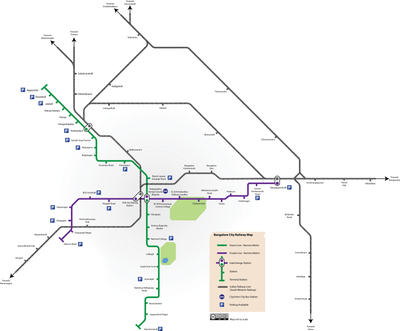Bengaluru Commuter Rail
Bengaluru Commuter Rail (Kannada: ಬೆಂಗಳೂರು ಪ್ರಯಾಣಿಕರ ರೈಲು) is a proposed suburban rail network for Bangalore which was first approved in the 2019 Railway Budget. On 1st February 2020, finance minister, Nirmala Sitharaman mentioned in her budget that the project would be implemented at cost of Rs 18,600 crores. While the central government would provide 20% of the equity and facilitate external assistance up to 60 percent of the project cost.
| Overview | |||
|---|---|---|---|
| Locale | Bengaluru, Karnataka, India | ||
| Transit type | Suburban rail | ||
| Number of lines | 4 | ||
| Operation | |||
| Operator(s) | Bangalore Suburban Rail Company Limited | ||
| Technical | |||
| System length | 200.0 kilometres (124.3 mi) | ||
| |||
History
The suburban rail services existed for HAL employees to commute from City Railway station to Vimanapura Railway station in 1963. However, a modern suburban rail system for Bangalore was first proposed in 2007. The proposal called for 10 routes totaling 204.0 km. The principal advantage of the system, according to the Rail Indian Technical and Economic Services (RITES), is that commuter rail costs less than rapid transit systems. It costs ₹ 150–200 million per kilometre for a commuter rail system, while metro rail would cost ₹ 2.50 billion and monorail ₹ 1.75 billion per km.
In November 2011, RITES conducted a feasibility study for suburban rail service in Bangalore and submitted the report to the Directorate of Urban Land Transport (DULT) in June 2012.[1] The final report was submitted in November 2012. The 179-page report proposed 3 long routes and 4 short distance routes making up a total rail network of 440.8 km. The 3 long routes were Bangalore-Mandya (92.88 km), Bangalore-Bangarpet (70.21 km), and Bangalore-Tumkur (64 km). The 4 short distance routes were Yeshwantpur- Yelahanka (12.45 km), Yelahanka-Baiyappanahalli (19.23 km), Yeshwantpur-Baiyappanahalli (16.12 km) and Yelahanka-Doddaballapur (20.72 km).[2]
The state government approved the suburban rail system on 5 July 2013. Chief Minister Siddaramaiah approved the system in the 2013-14 state budget that he presented on 9 July 2013.[3] The budget proposed the setting up of the Bangalore Suburban Rail Corporation Limited, a special purpose vehicle to implement the project, and allocated ₹87.59 billion (US$1.2 billion) to implement the system.[4][5] The DULT plans to build four of seven lines proposed by RITES.[6]
Union Railway Minister Suresh Prabhu announced of a partnership with Karnataka government for suburban railway network in Bangalore, in the 2016-17 railway budget, but did not allocate any money.[7] On 6 February 2016, the state government proposed a modified version of the original RITES plan. The government proposed constructing a rail link between Whitefield and Byappanahalli at an estimated cost of ₹1000 crore as Phase One of the suburban rail project.[8] The state government appointed RITES to study the feasibility of the project, and the latter's survey deemed the project was feasible. In November 2016, the Indian Railways and the Department of Urban Land Transport (DULT) also concluded that the project was feasible.[7] However, the Railways found that the proposed Phase Two of the project, linking Tumkur and Yeshwanthpur was not feasible.[9]
Routes proposed


Several routes have been proposed. The following four routes are part of the most recent proposal being studied by RITES:
- Ramanagara to Kengeri (32.0 km)
- Baiyyapanahalli to Hosur (41.0 km)
- Tumkur to Yeswanthpur (64.0 km)
- Yelahanka to Doddaballapura (24.0 km)
The routes proposed earlier were:
- Kengeri – Bangalore City Station (13.0 km)
- Bangalore City Station – Whitefield (24.0 km)
- Bangalore City Station – Baiyyappanahalli Via Lottegollahalli (23.0 km)
- Lottegollahalli to Yelahanka (7.0 km)
- Banasawadi up to BMA Boundary (29.0 km)
- Kengeri – BMA Boundary (9.0 km)
- Yeshwantpur to BMA Boundary (14.0 km)
- BMA Boundary – Hosur (12.0 km)
- BMA Boundary – Ramanagara (23.0 km)
- BMA Boundary – Tumkur (50.0 km)
Total: 204 km
An alternate proposal to CTTP was made by Praja Bangalore in July 2010. This route map was released as a part of the call to action report produced.[10]
References
- Aparajita Ray (18 June 2012). "RITES sent commuter rail feasibility study to DULT". The Times of India. Retrieved 7 April 2013.
- Suchith Kidiyoor (10 November 2012). "440-km commuter rail network planned in Karnataka". Dnaindia.com. Retrieved 30 July 2013.
- ref>Chitra V. Ramani (13 July 2013). "Green signal for suburban train system". The Hindu. Retrieved 30 July 2013.
- "Bangalore suburban rail a Kharge-Siddu dream". The Times of India. TNN. 13 July 2013. Retrieved 30 July 2013.
- "Govt to set up SPV to implement Bangalore suburban rail system". Business Standard. 12 July 2013. Retrieved 30 July 2013.
- "Commuter rail: Just a few miles more to start". Bangalore.citizenmatters.in. 15 July 2013. Retrieved 30 July 2013.
- "Phase 1 of suburban rail network feasible: George". The Times of India.
- "Suburban rail gets a push, railways to link 4 stations". The New Indian Express. Retrieved 18 November 2016.
- "Whitefield-Byappanahalli suburban rail link okayed". Deccan Herald. Retrieved 18 November 2016.
- "CRS: Call to Action Report".
